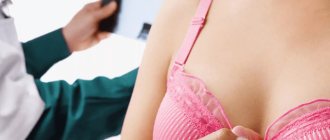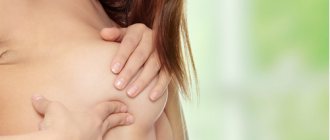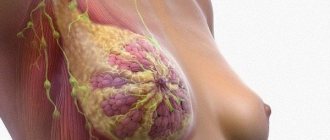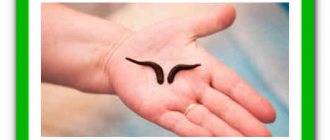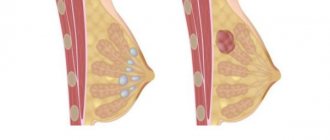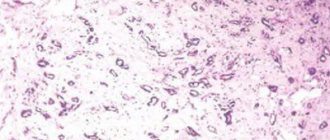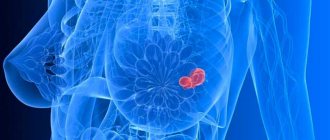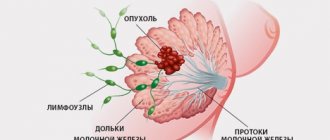Symptoms of the disease
Signs of fibrous mastopathy are characterized by pain and discharge from the nipples. Pain is the main symptom of the disease. Discharge from the nipples is observed somewhat less frequently. Symptoms may appear and intensify before the next menstrual cycle.
Photo: The process of development of fibrous mastopathy
Upon examination and palpation of the mammary glands, compacted areas are found that do not have clear boundaries, as well as formations like cysts with an elastic consistency, which are delimited from other areas. Formations can be bilateral. They typically increase in size on the eve of menstruation and decrease in size or disappear after menstruation.
Causes and factors for the development of mastopathy
Not a single specific factor has yet been identified that directly leads to fibrous mastopathy. All benign neoplasms have many identical causes associated with genetic predisposition, internal changes and external influences.
- Heredity - women whose mothers had cancer are more prone to bilateral fibrous mastopathy and its degeneration into a malignant neoplasm.
- Neuroendocrine dysfunction - increased levels of estrogen stimulate the growth of epithelial cells, and progesterone stimulates the growth of glandular components.
- Late first pregnancy and childbirth or lack thereof.
- The birth of a baby weighing more than 4 kilograms.
- Prolonged breastfeeding or, conversely, too short a lactation period.
- Woman's age - statistics show an increase in the number of cases of fibrous mastopathy in women around 40 years old, as well as a sharp increase in pathology rates after 60 years.
- Previously suffered mastitis (inflammation of the mammary gland).
- High-calorie foods and animal products that stimulate the secretion of estrogen and progesterone in a woman’s body.
- Psycho-emotional overload reduces the protective mechanisms of the immune system, which can provoke increased proliferation of breast cells and lead to the development of tumors in it.
- Irregular sex life or its prolonged absence.
- Use of contraceptives.
- Tobacco smoking.
In women of reproductive age, a connection has been established between the development of fibrous mastopathy and the presence of the following disorders:
- uterine bleeding associated with dysfunction of the reproductive glands;
- premenstrual syndrome;
- uterine fibroids;
- infertility;
- endometriosis.
Treatment of fibrous mastopathy
Treatment of fibrous mastopathy, as in principle the treatment of any other type of this disease, is based primarily on identifying and eliminating dysfunction of the endocrine glands, suppressing proliferative processes in the mammary gland, as well as treating urogenital diseases.
Quite often, fibrous mastopathy is treated with homeopathy. Such treatment allows not only to improve the patient’s condition, but also to achieve a complete cure. A significant point of such treatment is that it fights the root cause of the development of this disease.
We should pay tribute to the increase in the effectiveness of the main treatment of mastopathy with the help of dietary supplements from the Tianshi Corporation. Today, in the fight against this disease, a whole comprehensive nutrition correction program is used, consisting only of dietary supplements. The first stage involves the use of Antilipid tea, Biocalcium, Biozinc and Triestop classic tablets. This course of treatment will help cleanse blood vessels, normalize the metabolic process and increase your immunity. During the second stage, you will be offered such dietary supplements as Weikan, Holican, Eel Oil and Chitosan. These drugs support the liver and normalize the functioning of the endocrine system. The full course of treatment is two months. About three courses are needed per year.
However, if you trust only officially registered medications with proven effectiveness, consult with your doctor, who will prescribe the medicine and not the dietary supplement. This can be either hormonal or non-hormonal, depending on the clinical picture of the disease and many other factors.
Preventive measures
A woman should try to avoid severe stress and trauma to her breasts. During lactation, rules should be followed to avoid mastitis.
The main rule of prevention is regular self-examination of the mammary glands. To do this, in the first 7 days after the end of menstruation, you need to carefully palpate each breast in a lying position and carefully examine it in the mirror with your hands behind your head. In addition, it is also necessary to palpate the armpits and clavicle area.
Breast self-examination should be performed regularly
If you find areas of hardening, redness of the skin, asymmetry of the mammary glands, deformation of the nipples or discharge from them, if you feel pain and tension in the mammary glands, consult a doctor immediately.
Women after 40 years of age are recommended to undergo an ultrasound examination or mammography of the mammary glands every two years, and after 50 - annually.
How to reduce the manifestations of mastopathy
Seeing a doctor about fibrocystic mastopathy is almost useless. Swelling and tenderness of the breasts before menstruation is not considered a pathology, but rather one of the normal variants. However, the pain can be so severe that a woman literally cannot sleep for several nights in a row. In this case, the breasts can increase so much that the bra can become tight, or even small.
No doctor can tell you exactly how to treat fibrous mastopathy in the early stages. However, there are ways to reduce its manifestations. It has been noted that there are certain irritant substances that increase pain. In this row, caffeine and nicotine come first.
Therefore, you need to exclude coffee, Coca-Cola and chocolate from your diet, and you also need to stop smoking. You should not use chewing gum and tablets containing nicotine, as they, along with cigarettes, can increase pain.
It is also recommended to reduce the amount of saturated fat in your diet. That is, you need to eat less fatty meats, replacing them with fish and vegetable oils. A general reduction in calorie intake will not be harmful.
And, of course, treatment for fibrous mastopathy requires avoiding tight and uncomfortable underwear. You should discard any underwear that has hard areas in the form of pits or side inserts. You should also not wear tight underwear, especially those that correct the shape of your breasts.
Diagnostic methods
Diagnosis of all types of mastopathy is extremely important, since the presence of this pathology several times increases the risk of developing oncological tumors against this background. Malignant transformation of mastopathy can last a long time - up to 20 years. Therefore, a woman diagnosed with mastopathy should be under the constant supervision of a specialist.
First of all, the mammologist conducts an external examination and palpation of the mammary gland and nearby lymph nodes - axillary, supra- and subclavian, cervical, after which he refers for hardware diagnostics.
Until recently, the main and most accurate method for diagnosing fibrous mastopathy was considered to be an X-ray examination of the mammary gland - mammography. The accuracy of this diagnostic method is quite high in the presence of a large amount of fatty tissue in the mammary gland and, if necessary, to differentiate between cystic and fibrous formations.
Mammography allows not only to diagnose mastopathy, but also to detect cancer in the early stages
However, when examining young women with high-density mammary glands, the effectiveness of mammography raises some doubts. In addition, the use of X-rays for examining patients under 40 years of age is not recommended due to the harmful effects of ionizing radiation. Moreover, if such patients are subject to constant monitoring. In this case, the main diagnostic method becomes ultrasound examination (ultrasound), which is safe for the woman’s body. Modern ultrasound equipment is highly accurate and can effectively detect small nodules no larger than 2 mm in diameter.
Examination of the breast using an ultrasound machine is a safe procedure
Echo signs of mastopathy detected by ultrasound will help differentiate different forms of the disease:
- Diffuse form - multiple small fibrous compactions or cysts, evenly distributed throughout the gland;
- Fibroadenomatosis - single dense formations with clear boundaries;
- Cystic form - cavities filled with liquid contents that change shape when pressed;
- Fibrocystic form - both cavities with fluid and compactions with clear boundaries are simultaneously present.
To clarify the diagnosis, a mammologist may recommend additional examinations:
- puncture (fine needle aspiration) of fibrous or cystic nodes followed by histological examination of the selected material;
- laboratory blood test, including breast tumor marker CA-15–3;
- computer (CT) and magnetic resonance imaging (MRI) - accurate scanning of the mammary gland, which allows identifying the slightest malignant formations at the earliest stages.
ethnoscience
Even the majority of representatives of official medicine will say that for a disease such as fibrous mastopathy, treatment with folk remedies is practically the only way out. Some remedies, proposed by the people a very long time ago, are currently recognized by all European doctors and are produced widely.
For example, in pharmacies and catalogs of companies producing dietary supplements, you can easily find herbal tea with red brush or angelica. These herbs have beneficial effects on breast tissue. For fibrous mastopathy of the mammary glands, treatment with red brush infusion is literally akin to a miracle. This remedy helps even in advanced cases and in later stages. It not only reduces pain, but also promotes the resorption of compactions and improves tissue consistency.
Herbal tea with boron uterus can also provide some help, especially in cases where the main cause of the development of fibrous mastopathy is diseases of the uterus and ovaries.
How to treat fibrous mastopathy with these herbs? Very simple. It is enough to brew herbal tea or mixture once a day and leave for fifteen minutes. The infusion must be consumed in several doses. It is advisable to divide the infusion into three equal portions according to meals.
Pepper Knotweed
Pour two tablespoons of dry peppermint herb into a glass of boiling water, let it brew for 15-20 minutes, then separate the liquid from the herb. Moisten gauze or bandage with the infusion and apply lotions to the chest two to three times a day.
If the patient has a combination of thrombophlebitis and fibrous mastopathy of the mammary glands, treatment with knotweed is contraindicated. Since, along with anti-inflammatory and antioxidant effects on gland tissue, this plant can provoke an exacerbation of vascular inflammation.
Burdock leaves
Fibrous mastopathy, treatment of which with folk remedies becomes the only way out, responds well to treatment with burdock leaves. The most effective option is to apply fresh leaves overnight. Only this method is available only in summer. In winter, an infusion is prepared from which lotions are made. To do this, take 2 tablespoons of dried burdock leaves and pour a glass of boiling water. After the infusion acquires a characteristic color, it must be strained. Lotions are applied at night.
Cabbage leaves
Take a cabbage leaf, rinse it under running water, cut off any hard parts. Place in your bra overnight. There is also a version of this recipe using honey. The leaf is smeared with honey and applied for 2-3 hours.
It is worth noting that honey, unlike all other remedies used for fibrous mastopathy, has an irritant and not an anti-inflammatory effect. Therefore, this treatment option is used in the later stages, with pronounced lumps in the mammary gland.
Rhodiola rosea root
Take carrots, grate them finely and mix with beet juice. Add a tablespoon of dried and powdered Rhodiola rosea root, as well as two teaspoons of sea buckthorn oil. Mix all ingredients until smooth.
Apply the resulting mixture onto a linen napkin and apply it to your chest overnight.
The essence of the disease
Experts distinguish two types of mastopathy - diffuse, in which tissue compactions and small nodules appear, and nodular, accompanied by the formation of large nodules.
The diffuse form is the initial stage of the disease; in the absence of adequate treatment, it can develop into a nodular form and cause various complications. Breast cancer often develops against the background of fibroadenomatous mastopathy.
The diffuse form occurs with a predominance of the cystic or fibrous (glandular) component; a mixed form, fibrocystic disease, is also found. As cystic mastopathy progresses, large cysts (up to 5-7 cm) are formed, and with further development of the fibrous form, the patient may develop fibroadenomas - benign tumors.
So what is fibromatous mastopathy? This disease is an overgrowth of the connective tissue of the breast. If the fibrous component predominates, then the mammary gland framework grows due to active cell division between the lobules. At the same time, increased division of cells that line the ducts occurs. Under the influence of these factors, a narrowing occurs, and if left untreated, the lumen of the duct is completely blocked.

